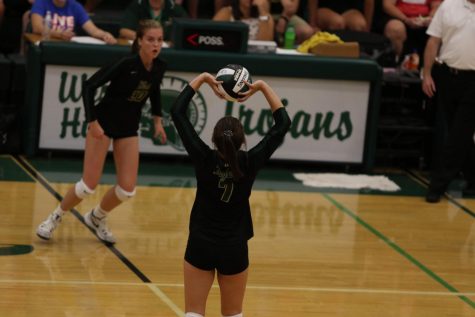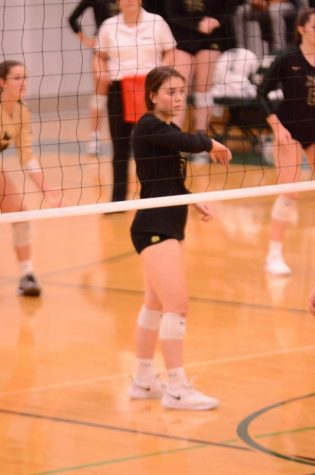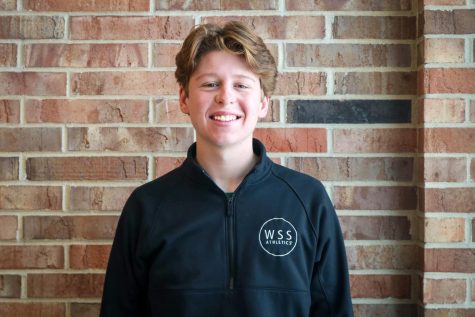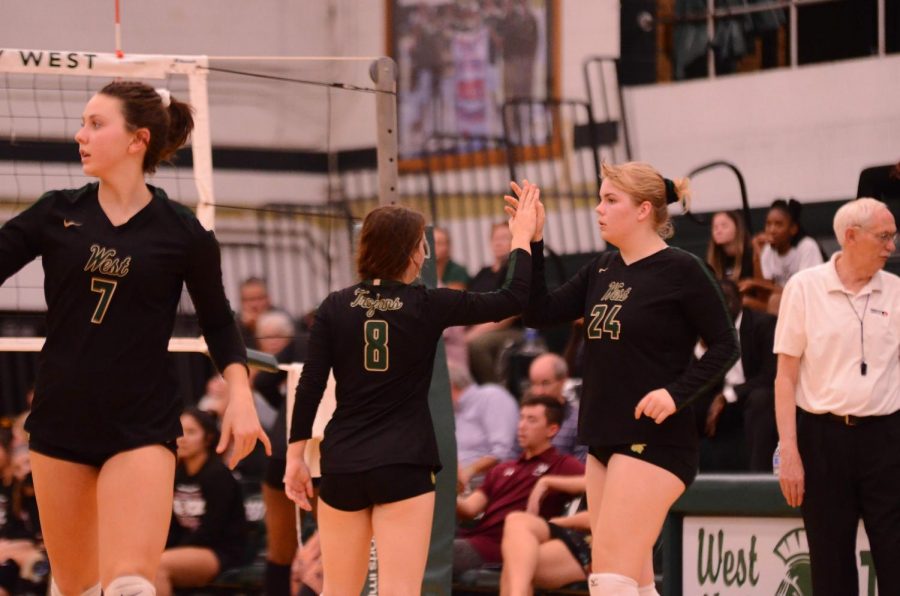Trojan Workhorses: Emma Dunlap ’22 and Kearsten Lenth ’22
The Trojan Workhorses series aims to showcase athletes who are not often recognized for their accomplishments, but are crucial to their team’s success. This first installment highlights the volleyball team setters’ subtle leadership and pivotal playmaking.
Setters Kearsten Lenth ’22 and Emma Dunlap ’22 encourage their teammates after scoring a point against Waterloo West on Sept. 29.
There is no pitcher without a catcher. There is no quarterback without a center.
In the sport of volleyball, there are no spikes without a setter.
The high-flying six-foot hitters that dominate the air affair are typically the focus of any casual volleyball spectator. However, most seem to forget the smaller, speedier setters creating all of the action with a simple flick of the wrists.
Head volleyball coach Scott Sanders has entrusted two of his younger players, sophomores Emma Dunlap and Kearsten Lenth, to lead his team from the setter position this fall.
“A setter, you could think of them like a quarterback,” Sanders said. “They touch every contact or every series. It’s a pretty crucial position.”
The setter is the energy source for any successful volleyball team. The primary responsibilities of the setter are calling plays, controlling the offense and—of course—setting the ball for the team’s hitters to spike across the net and score.

Emma Dunlap ’22 sets the ball for her hitter during the Battle for the Spike at West High on Aug. 27.
In sports like football and basketball, the leader of the team is on center stage. Quarterbacks and point guards have the ball in their hands more than any other player and are able to showcase their skills at will, much to the approval of the crowd.
If you don’t watch too much volleyball, you may not have even noticed it was the same person setting the ball before each hit, or that the position of setter even existed.
The setter’s leadership is more about staying positive and being vocal on the court. The setter is charged with correcting the misplays of the first hit and making sure the second ball is still able to be played by the hitter.
“A lot of the weight gets put on setters because if the hit’s not there the setter is automatically like ‘oh no what did I do wrong’,” said Lenth, who transferred from Liberty last year. “If the pass isn’t there the set has to go run and get it.”
In addition to having a complete understanding of their own offense, the setter must also be conscious of the opponent’s alignment in order to counteract their strengths and exploit their weaknesses.

Kearsten Lenth ’22 eyes her opponents across the net before the serve in a game against Waterloo West on Sept. 29.
“I have lots of different options so I just have to assess what’s going on on the other side of the net so I can make my best decision,” Dunlap said. “The most important thing on the other side of the net would be blockers.”
The rest of the team certainly respects the effort and responsibility that is shared between Dunlap and Lenth. Defensive liberos always appreciate a good setter to correct their digs, while the hitters are dependent on the setters for their spikes.
“The setter is definitely the hardest position on the team because you have to call all of the plays and you have to make sure that you get there so that the offense can be run,” said hitter McKenna Proud ’21, who leads the team with 94 kills. “Then all of the hitters are picky about where they want their sets, so it’s just difficult to try and figure out where to put the sets so that the hitter can get the most amount of kills.”
Dunlap and Lenth have a combined 250 assists this season playing in a 6-2 rotation. A 6-2 rotation means the team rotates between two primary setters, allowing for an extra offensive player to play in the front row.
While the two-setter system gives the team more offensive firepower, it can be difficult for hitters to get comfortable with two different leaders on the floor. The system equates to the football team having two quarterbacks.
“We’ve got the hitters to compensate for running a 6-2. Neither of [the setters] are great blockers,” Sanders said. “You get more kids out there, but we’re limited to the number of subs we can make in a match.”
This year’s volleyball team has eight sophomores, six juniors and only one senior. With the program in a rebuilding phase, Sanders has been eyeing his loaded sophomore class to develop into the leaders of the future.
“I would love to be seen as one of the leaders,” Lenth said. “I’m slowly progressing because I came into West this year…so I had to meet everyone but now I’m getting comfortable with everyone.”
One of the biggest keys going forward will be gelling the young players and developing stronger team chemistry on the court. As the focal points of the offense, most of that responsibility will fall to Dunlap and Lenth, both of which have shown the willingness to take control of the team’s future.

Kearsten Lenth ’22 rallies her teammates around her after a point against Waterloo West on Sept. 29.
“I like [setting] a lot because I have a lot more authority on the court…you get the pass and you have to make something out of it and turn it into a ball that your hitters can play on,” Dunlap said. “I just like having the choice. You’re a lot more mentally involved when you’re setting.”
The sophomore class has some high goals in mind for the years to come, but right now they are focused on their rivals across town.
“I’m very excited for the next coming years because that’s when we’re going to be seeing all the improvement,” Dunlap said. “I want to beat City and Liberty in future years, I think we can and that would be good for me.”
Your donation will support the student journalists of West High School. Your contribution will allow us to purchase Scholarship Yearbooks, newsroom equipment and cover our annual website hosting costs.

Joe is in his second year working for the West Side Story publications as the sports editor. Joe plays golf, basketball and runs track at West High. He...

Owen Aanestad is a senior at West. This is his third year on staff working for the online publication as the online editor-in-chief In addition to playing...

(she/her) Alyssa Skala is a senior at West. She is a third year photographer on staff and a second year editor for yearbook. When she doesn't have her...



